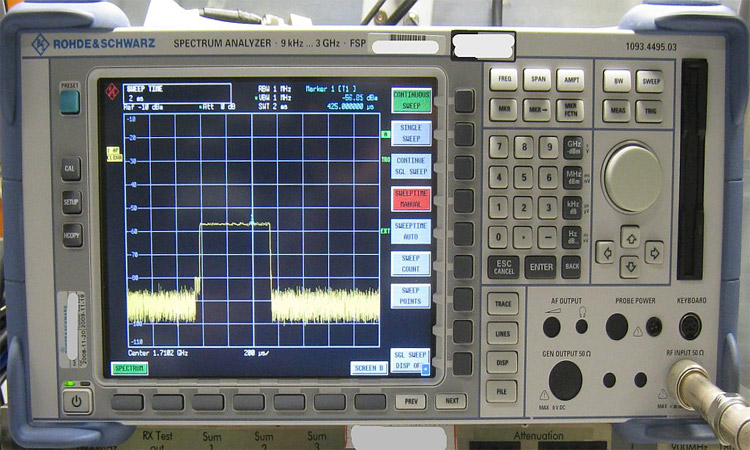The introduction of spectrum analyzers bought a dynamic advancement in the technological industry. These devices perform the function of quantifying and measuring the magnitude of signals received in comparison to the frequency scale of the analyzer device.
The primary role of spectrum analyzers is to measure the strength induced by the spectrum of rectified and non-rectified signals that are being received. The input signals that are being received and measured by these devices are electrical in nature. Another device known as the transducer is used to measure and record various other spectral configurations. Examples of this can be acoustic pressure waves and optical light waves. Another category of spectrum analyzers is the optical spectrum analyzer. This variety of spectrum analyzers makes use of direct optical methodology such as the monochromator. The monochromator technique efficiently records and takes measurements of the signals received. The spectrum analyzers are basically devices that record selective frequencies. They consist of voltmeters that can easily detect and measure sine waves. The voltmeters, however, have to be adjusted in order to get the correct rms value of the sine wave. The frequencies measured by the spectrum analyzers are displayed on the horizontal axis and the amplitude is exhibited on the vertical axis.
Spectrum analyzers are subject to two categories:
- Digital Spectrum Analyzers
- Analog Spectrum Analyzers
Digital analyzers are a more popular option in comparison to the analog variety. With the RF blockage worsening day by day, more and more users are starting to understand the importance of having and using a real-time spectrum analyzer. With digital advancements in every nook and corner of the world, the importance of digitization cannot be understated. The major benefit of employing real time digital spectrum analyzers is that these devices offer on the spot analysis and envisionment of the RF conditions prevalent without having to wait for individual inception.
Functioning of spectrum analyzers
Spectrum analyzers provide users with the option of recording frequencies and set them at the start, stop, and center frequency respectively. Center frequencies serve as the axis for measuring the overall span between that of the start frequency and the stop frequency. It can be termed as the mid-point of the start frequency and the stop frequency. These make use of the RF element present in them to record the radio signals. Other functions of spectrum analyzers comprise of the following:
- Measuring the frequency: The spectrum analyzer studies the frequency of a given spectrum
- Peak indicator: This is responsible for monitoring and controlling the orientation of the marker. This helps in analyzing the peak of a spectrum and determine the real value of power.
- Bandwidth: Bandwidth is used as a resolution filter and the analyzer records the movement in frequency.
- The amplitude of signals: Amplitude is utilized to estimate the peak point of the signal strength.
Main features of spectrum analyzers
With technological advancements on the verge of rising, the development of spectrum analysis software has driven convenience and made thing easier for many. People nowadays are making use of the analyzer apps as well. The spectrum analyzers are capable of converting analog signals into digital signals efficiently and draw out a sample input signal reading and frequency parameters. An up-to-date spectrum analyzer may even be able to display scaled levels of noise. These noise levels can also be calculated. These devices are proficient in:
- Sample detection
- Peak detection
- Average detection
Different types of spectrum analyzers
Below mentioned are the different types of spectrum analyzers available:
- Swept spectrum analyzers: Also known as the superheterodyne spectrum analyzer converts a unit of the input signal received to the center frequency restricted to a filter that uses very low power. With the help of this, the whole spectrum gets analyzed. In the case of a swept spectrum analyzer, the resolution pertaining to the bandwidth is in close proximity with the bandwidth that can be easily detected by the equipment. It is monitored and controlled by a band-pass filter . It should be noted that if the bandwidth must be of minimum value in order to capture greater spectral resolution.
- FFT analyzers: Fourier transforms, another type of spectrum analyzer is a way of breaking down the signals into single frequencies. This kind requires a sampled frequency range that is two times the size of the bandwidth.
- Real-time spectrum analyzers: These analyzers collect bandwidth ranges on a real-time basis. They survey the RF received in a specific time frame. The information received is then converted by utilizing the FFT algorithms. This method does not include any gaps in time as it is purely real-time.
- Audio spectrum analyzers: This converts sound signals into volumes that are audible to the human ear. The audio spectrum analyzer is proficient in monitoring the audible signal harmonics. These are also known as wave spectrum analyzers. These are mostly used by sound engineers. These analyzers can run on any device or computer that is equipped with a sound card.
Uses of spectrum analyzers
Spectrum analyzers are used to check if a wireless transmitter is functioning as per the federal laws and standards. These are also commonly used to estimate the bandwidth pertaining to a digital or analog signal. Spectrum analyzers are useful to test equipment for any radio frequency engineer. Avcom is a leading integrated technology company known for the manufacturing of commercial spectrum analyzers equipment in the USA.
Image Source: https://creativecommons.org/licenses/by-sa/3.0


Be the first to comment on "Spectrum Analyzers Fundamentals, Types, and Uses"